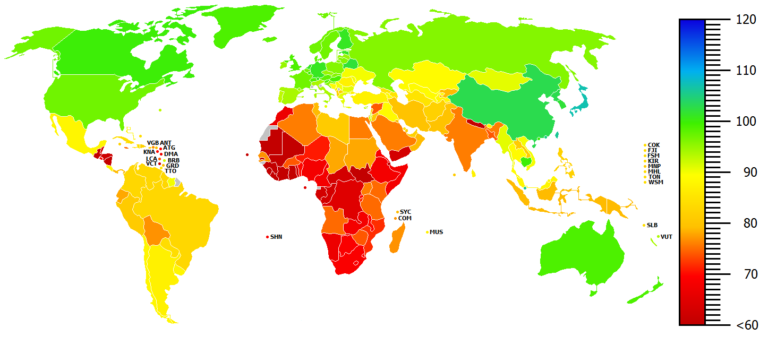Rushton Vindicated: Intelligent People Learn to Walk Later, Just as He Predicted
For those who are fascinated by what is sometimes called “Based Science” — science which fearlessly examines the empirical evidence no matter how “controversial” the findings might be — a breakthrough took place recently: “Rushton’s Paradox” was solved at last, using genomic data. To those who are not initiated, this may sound rather abstruse and academic, but it is massively important: It is a breakthrough.
The theory of one of the most “controversial” scientists ever to live has finally been proven correct: At the individual level, intelligence — the ability to solve cognitive problems — is associated with a slow Life History Strategy, i.e., developing more slowly because you are evolved to a more difficult and highly specific environment, in which you need a long “learning period” — a long childhood — to be taught how to navigate. The implications of this are enormous, but, before we explore them, let’s have a look at the broader theory.
Even though he’s been dead for 12 years, there are few social scientists more loathed by the Woke than J. Philippe Rushton (1943-2012). As I have discussed in my biography of him, J. Philippe Rushton: A Life History Perspective, the Canadian government tried to prosecute this British-born Canadian when, back in 1989, he presented his Differential-K model of racial differences at a conference. This model placed Blacks at one end of a spectrum and East Asians at the other, with Whites intermediate in terms of intelligence, psychopathic personality, age at puberty, interest in promiscuous sex over investment and nurture, and much else, but closer to East Asians.
In the resulting furore, students invaded Rushton’s department at the University of Western Ontario and scrawled “Racist Pig Lives Here” on his office door, the premier of Ontario declared that Rushton’s views were “morally offensive” to how people of his state think, newspaper cartoons portrayed Rushton in Ku Klux Klan robes, his lectures were invaded by protestors, his faculty dean tried to wreck his career with a politically-motivated “unsatisfactory” rating and he required a security escort while on campus. Even so, there was no legal case against him and, in 1995, he doubled-down, publishing Race, Evolution and Behavior: A Life History Perspective which set out his theory in depth.
According to Rushton, an r-strategy develops in an unstable yet easy environment. In such a situation, you could be wiped out at any moment, so you evolve to “live fast and die young.” You invest all your energy in mating—in order to have as many offspring as possible with as many partners as possible in the hope that some will survive. You invest very little energy in nurture, because such energy could easily go to waste. Any individual child could be killed at any moment.
This r-strategy is reflected in every aspect of your “life history”—you’re born younger (less developed), you reach developmental milestones younger, you go through puberty younger, lose your virginity younger, you age more quickly, you go through the menopause younger and you die younger. You also advertise your genetic quality as conspicuously as you can—as the end is always nigh—leading to large sexual characteristics, strong body odor, and so on. Rushton presented some of these data in Race, Evolution and Behavior and I added to them in my biography of him.
As the environment becomes more stable and also harsher, the carrying capacity for the species is reached. So, its members start competing more against each other to survive, moving towards a K-strategy. In such a harsh but predictable context, if you invest all your energy in mating then you may find that all of your offspring die. Hence, you have fewer offspring and fewer sexual partners but you invest more in them; you “nurture” them. There develops an arms-race where the species becomes increasingly adapted to the (predictable) ecology.
It does this by learning about the ecology and learning how to cooperate (bonding) and thus becoming higher in altruism, empathy and impulse control — and, perhaps most importantly, by becoming more intelligent. The result is that the offspring can learn about the environment and how to cooperate—and “life history speed” begins to slow down. Parents invest more energy in nurture of a (smaller number of) offspring and less energy in mating. They go for “quality over quantity.” With limited bio-energetic resources, secondary sexual characteristics also become smaller.
As they become more K-strategy, in a stable environment where they can trust that tomorrow will come, litters become smaller, offspring are born later, they develop more slowly, they go through puberty later (learning a great deal in their long childhood), they lose their virginity later, they age more slowly and, for genetic reasons, they die older, giving them more time to pass on their genes. Rushton showed that what he called the “three Big Races” occupy different positions on the r-K spectrum. Northeast Asians are the most K-evolved, Caucasians (a combination of Europeans, South Asians, Arabs and North Africans) are intermediate and Blacks are the most r-evolved.
Rushton’s Paradox was always that evidence could not be found that intelligence correlated with Life History Speed at the individual level, even though it did at the group level. This was so puzzling — and such a problem for the cleanness of Rushton’s model, that he may even have falsified data or otherwise manipulated his results to prove that such a relationship did exist, as I explored in J. Philippe Rushton: A Life History Perspective.
I also note there that, as appears to be the case with many genius or semi-genius (highly original) scientists, Rushton’s life evidenced a combination of a very high intelligence and fast Life History traits such as sub-clinical psychopathology [see F. Post, Creativity and Psychopathology: A Study of 291 World Famous Men, British Journal of Psychiatry, 1994]. This meant he didn’t care about offending people (which new ideas always do, as they challenge vested interests), and he was low in rule-following (so could think the unthinkable). Consistent with this, he was divorced three times, had extra-marital affairs, knocked his third wife about, had an illegitimate child by a relationship with a Black woman, dropped out of school and got a girl of about 15, and possibly younger, pregnant.
But if Rushton did falsify data, he needn’t have done so. A new study has proved him correct. The preprint “Genome-wide association meta-analysis of age at onset of walking” by Anna Gui and colleagues has presented a meta-analysis of age at onset of walking, using data on 70,560 European infants. It looked at the relationship between age of onset of walking and alleles that are associated, via very high educational attainment, with intelligence. It found that the age at which you start walking is positively correlated with polygenic scores for intelligence: Kids who are eventually more intelligent learn to walk later; their childhood is longer.
And as if Rushton — with his penchant for “controversy” — laughing from beyond the grave, even this has stirred things up. Researcher Emil Kirkegaard has noted that this new study was originally tweeted out by a mainstream academic. He then deleted the tweet stating: “Unfortunately, it has attracted many racist responses that abused the study to make ugly, racist claims.” There were no racist claims, but it did vindicate Rushton’s theory.
It also adds credence to an idea I have been toying with for quite a while. Why is it that, in advanced societies, intelligent people desire fewer children and why are they less religious than the less intelligent?
One possibility is that these are in-built instincts that are induced in our “evolutionary match” of high mortality salience and the desire to have children. As I explored in my book Breeding the Human Herd: Eugenics, Dysgenics and the Future of the Species, we’ve been surrounded by high child mortality for most of our history. This is our “evolutionary match”: We desired many children because it was quite probably that many would die before adulthood. You would expect the more intelligent to be lower in “instinct” because solving problems involves rising above instinctive reactions and calmly and logically reasoning. It would follow that intelligent people would be more environmentally sensitive; they would be K-strategists, needing to be put on the correct road-map of life to adapt to a specific niche. If this didn’t happen — if they were in a mismatch — they’d become maladaptive, such as by not desiring children. So, the new finding is in line with this theory.
There may have been much to dislike about Rushton personally, but this is part of why he was a highly original thinker. With this new research, his grand theory has been vindicated.




 Race and Sport: Evolution and Racial Differences in Sporting Ability
Race and Sport: Evolution and Racial Differences in Sporting Ability


